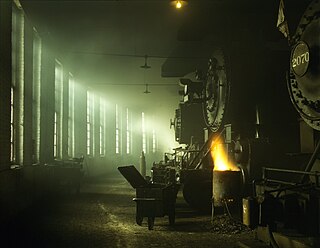Related Research Articles

America's first transcontinental railroad was a 1,911-mile (3,075 km) continuous railroad line built between 1863 and 1869 that connected the existing eastern U.S. rail network at Council Bluffs, Iowa, with the Pacific coast at the Oakland Long Wharf on San Francisco Bay. The rail line was built by three private companies over public lands provided by extensive U.S. land grants. Building was financed by both state and U.S. government subsidy bonds as well as by company-issued mortgage bonds. The Western Pacific Railroad Company built 132 miles (212 km) of track from the road's western terminus at Alameda/Oakland to Sacramento, California. The Central Pacific Railroad Company of California (CPRR) constructed 690 miles (1,110 km) east from Sacramento to Promontory Summit, Utah Territory. The Union Pacific Railroad (UPRR) built 1,085 miles (1,746 km) from the road's eastern terminus at the Missouri River settlements of Council Bluffs and Omaha, Nebraska, westward to Promontory Summit.
David Brooks may refer to:

The Timeline of U.S. Railway History depends upon the definition of a railway, as follows: A means of conveyance of passengers and goods on wheeled vehicles running on rails, also known as tracks.
The Pacific Railroad Acts of 1862 were a series of acts of Congress that promoted the construction of a "transcontinental railroad" in the United States through authorizing the issuance of government bonds and the grants of land to railroad companies. In 1853, the War Department under then Secretary of War Jefferson Davis was authorized by the Congress to conduct surveys of five different potential transcontinental routes from the Mississippi ranging from north to south. It submitted a massive twelve volume report to Congress with the results in early 1855. However, no route or bill could be agreed upon and passed authorizing the Government's financial support and land grants until the secession of the southern states in 1861 removed their opposition to a central route. The Pacific Railroad Act of 1862 was the original act. Some of its provisions were subsequently modified, expanded, or repealed by four additional amending Acts: The Pacific Railroad Act of 1863, Pacific Railroad Act of 1864, Pacific Railroad Act of 1865, and Pacific Railroad Act of 1866.

Standard time is the synchronization of clocks within a geographical region to a single time standard, rather than a local mean time standard. Generally, standard time agrees with the local mean time at some meridian that passes through the region, often near the centre of the region. Historically, standard time was established during the 19th century to aid weather forecasting and train travel. Applied globally in the 20th century, the geographical regions became time zones. The standard time in each time zone has come to be defined as an offset from Universal Time. A further offset is applied for part of the year in regions with daylight saving time.
The Erie Railroad was a railroad that operated in the Northeastern United States, originally connecting Pavonia Terminal in Jersey City, New Jersey, with Lake Erie at Dunkirk, New York. The railroad expanded west to Chicago following its 1865 merger with the former Atlantic and Great Western Railroad, also known as the New York, Pennsylvania and Ohio Railroad. Its mainline route proved influential in the development and economic growth of the Southern Tier of New York state, including the cities of Binghamton, Elmira, and Hornell. The Erie Railroad repair shops were located in Hornell and was Hornell's largest employer. Hornell was also where Erie's mainline split into two routes with one proceeding northwest to Buffalo and the other west to Chicago.

Matthew Baird was one of the early partners in the Baldwin Locomotive Works.

The Cadillac & Lake City Railway was a railroad which operated in the Midwestern United States. The operation was owned by Western States Properties, Inc. and several investors who operated lines in three states; Colorado, Kansas, and Michigan during its time.
The Central Overland Route was a transportation route from Salt Lake City, Utah south of the Great Salt Lake through the mountains of central Nevada to Carson City, Nevada. For a decade after 1859, until the first Transcontinental Railroad was completed in 1869, it served a vital role in the transport of emigrants, mail, freight, and passengers between California, Nevada, and Utah.

A vestibuled train is a passenger train whose cars have enclosed vestibules at their ends, in contrast to the open platforms on early cars. Typically, a vestibule has doorways on either side to allow passenger entry and exit at stations, a door into the body of the car, and, at the car end, a doorway to allow access to the next car through a flexible gangway connection.

The Crusader was a 5 car stainless steel streamlined express train that ran on a 90.3-mile (145.3 km) route from Philadelphia's Reading Terminal to Jersey City's Communipaw Terminal, with a ferry connection to Lower Manhattan at Liberty Street. The Reading Railroad provided this service in partnership with the Central Railroad of New Jersey (CNJ), in which it was the majority owner of capital stock. Trains including the Crusader ran on Reading Railroad tracks from Reading Terminal in Philadelphia to Bound Brook, NJ, where they continued on CNJ tracks to Communipaw Terminal in Jersey City. Passengers then left the train and walked aboard the ferry or boarded busses that loaded onto the ferry. Introduced in 1937, the Crusader service declined during the 1960s, and the name was ultimately dropped in 1981.

The Bell System was a system of telecommunication companies, led by the Bell Telephone Company and later by the American Telephone and Telegraph Company (AT&T), that dominated the telephone services industry in North America for over 100 years from its creation in 1877 until its antitrust breakup in 1983. The system of companies was often colloquially called Ma Bell, as it held a vertical monopoly over telecommunication products and services in most areas of the United States and Canada. At the time of the breakup of the Bell System in the early 1980s, it had assets of $150 billion and employed over one million people.

The Northern Central Railway of York is a non-profit, Civil War themed heritage railroad based in New Freedom, Pennsylvania. A reproduction 4-4-0 steam locomotive hauls passengers over 10 miles of Northern Central Railway track between New Freedom and Hanover Junction, Pennsylvania. The operation was originally named Steam into History and held its grand opening on June 1, 2013. In 2019 it took up the historical name Northern Central Railway.

Charles Minot was an American railroad executive at the Erie Railroad, where in 1850 he became Superintendent as successor of James P. Kirkwood, and was succeeded by Daniel McCallum in 1854. After the bankruptcy of the Erie in 1859 he was reinstated as general superintendent of the Erie railroad.

Brookfield Glass Company was an American glass company based in Brooklyn, New York, from 1864 to c. 1912, and in Old Bridge, New Jersey, from c. 1906 to 1921. it was known for producing industrial glassware such as jars, bottles, and electrical insulators. The company's business began as the Bushwick Glass Works in Brooklyn in c. 1860, and operated as the Brookfield Glass Company from 1898 until dissolution of the company in 1922.
Henry Roe Campbell was an American surveyor and civil engineer. Campbell contributed to American railroading and bridge-building in the first half of the 19th century. Campbell patented his 4-4-0 design in February 1836, just a few months before the patent law was changed to require that claims include proof of originality or novelty.